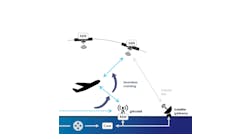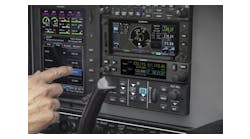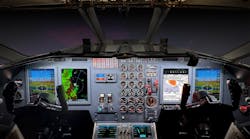EAST AURORA, N.Y., February 22, 2016 - Astronics Corporation (NASDAQ: ATRO), through its wholly-owned subsidiary Astronics Max-Viz, commended the Federal Aviation Administration's General Aviation Joint Steering Committee (GAJSC) for recent statements in support of enhanced vision technology to improve general aviation safety in situations involving weather, night, smoke and other obstructions to vision. Max-Viz develops Enhanced Vision Systems (EVS) that enable increased pilot visibility, especially in darkness and adverse weather conditions.
"In a recent Safety Briefing from the Federal Aviation Administration, the GAJSC wrote it had concluded that Enhanced and Synthetic Vision technology can significantly improve general aviation utility and reduce the chance of accidents during night and instrument metrological conditions," said Elliott Troutman, Astronics Max-Viz Executive Vice President.
"This official FAA recognition of the safety advantages of enhanced vision and the attention it brings to this potentially lifesaving technology is very important for all general aviation pilots,"Mr. Troutman added. "Getting this word out to the pilot community and the fact that this relatively inexpensive flying technology can save lives is really crucial for all facets of general aviation."
FAA Recognition of EVS Safety Enhancements
The FAA's recent statements indicated, that enhanced vision "technologies fall into two categories, Enhanced Vision (EV) and Synthetic Vision (SV). EV systems use sensors to provide a better view of the outside world. These sensors can be something like infrared or radar, each of which have their own advantages and disadvantages. Of course, it's nice to be able to see wildlife and other obstructions on the runway, but they're also quite useful in depicting terrain in bad weather or on a dark night..."
Per the FAA, "SV differs from EV in that it doesn't use sensors to 'see' outside. Instead SV relies on GPS information and a database to create a virtual representation of the world outside... Almost as important as what you are displaying is how you are displaying it. A Head Up Display (HUD) is an ideal way of displaying EV/SV information, but these are expensive and fairly rare in most of GA. Most GA systems are displayed through a cockpit Multifunction Display (MFD) or Primary Flight Display (PFD). No matter which display method you use, be sure you train with it enough to be proficient before taking it out 'in the soup.'"
For the complete briefing go to https://www.faa.gov/news/safety_briefing/2015/media/SE_Topic_15-12.pdf.
Per the FAA, "SV differs from EV in that it doesn't use sensors to 'see' outside. Instead SV relies on GPS information and a database to create a virtual representation of the world outside... Almost as important as what you are displaying is how you are displaying it. A Head Up Display (HUD) is an ideal way of displaying EV/SV information, but these are expensive and fairly rare in most of GA. Most GA systems are displayed through a cockpit Multifunction Display (MFD) or Primary Flight Display (PFD). No matter which display method you use, be sure you train with it enough to be proficient before taking it out 'in the soup.'"
For the complete briefing go to https://www.faa.gov/news/safety_briefing/2015/media/SE_Topic_15-12.pdf.
Astronics Max-Viz EVS Provides Outstanding Vision Range in Adverse Visibility Conditions
The Astronics Max-Viz EVS is a best-in-class solution that enables pilots to see up to ten times further than unaided human vision in visibility-obscured conditions, such as smoke, haze and light fog, day or night. Max-Viz EVS features lightweight, solid-state, thermal cameras with a sensor image that can be displayed on a wide range of multifunction and primary flight displays and electronic flight bags systems.
Astronics Max-Viz Enhanced Vision Systems will be on display at Helicopter Association International's Heli-Expo 2016, March 1-3 in Lexington, KY, at the Astronics Corporation booth.
ABOUT THE GENERAL AVIATION JOINT STEERING COMMITTEE
The General Aviation Joint Steering Committee (GAJSC) is a public-private partnership working to improve general aviation safety. The GAJSC uses a data-driven, consensus-based approach to analyze aviation safety data and develop risk reduction efforts.The GAJSC's goal is to reduce theGA fatal accident rate per 100,000 flight hours by 10% from January 1, 2009 to December 31, 2018, with no more than 1 fatal accident per 100,000 flight hours by 2018.
ABOUT ASTRONICS MAX-VIZ ENHANCED VISION SYSTEMS
Astronics Max-Viz Enhanced Vision Systems are designed for turbine and piston, fixed and rotary wing aircraft. The systems use infrared sensors, signal processing, and advanced cockpit displays to show terrain, runways, taxiways, aircraft and obstacles in poor visibility conditions, including light fog, haze, smoke, smog, light precipitation and darkness all within a package that is compact, lightweight, reliable and affordable.
Astronics Max-Viz Enhanced Vision Systems are approved for numerous models of aircraft manufactured by AgustaWestland, Textron (Bell Helicopter, Beechcraft, Cessna), Boeing, Bombardier, CASA, Canadair, Cirrus, Dassault, Eurocopter, Gulfstream, Learjet, Pilatus, Piper, Robinson Helicopter and Sikorsky Aircraft. For more information, go to www.max-viz.com.
ABOUT ASTRONICS CORPORATION
Astronics Corporation (NASDAQ: ATRO) is a leading supplier of products to the global aerospace, defense, consumer electronics and semiconductor industries. Astronics' products include advanced, high-performance electrical power generation and distribution systems, lighting and safety systems, avionics products, aircraft structures, engineering design and systems certification, and automated test systems. Astronics' strategy is to increase its value by developing technologies and capabilities, either internally or through acquisition, and using those capabilities to provide innovative solutions to its targeted markets and other markets where its technology can be beneficial. Astronics Corporation, through its wholly-owned subsidiaries, has a reputation for high-quality designs, exceptional responsiveness, strong brand recognition and best-in-class manufacturing practices. The Company routinely posts news and other important information on its website. For more information on Astronics and its products, visit its website at www.Astronics.com.



